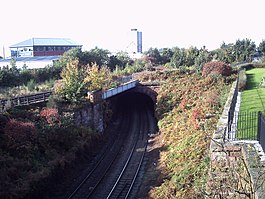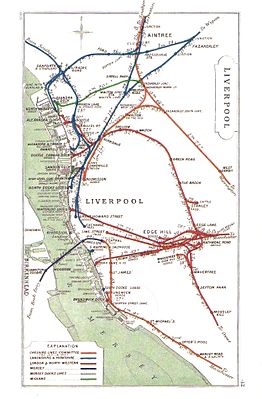Canada Dock Branch
| Canada Dock branch | |||
|---|---|---|---|
 Canada Dock branch passes under the Merseyrail Northern Line near Balliol Rd entering the dock complex | |||
| Overview | |||
| Status | Operational | ||
| Owner | Network Rail | ||
| Locale | United Kingdom (Liverpool North West England) | ||
| Stations | 0 | ||
| History | |||
| Opened | 1866 | ||
| Technical | |||
| Line length | 4 mile 59 chain (7.62 kilometre) | ||
| Track gauge | 1,435 mm (4 ft 8+1⁄2 in) standard gauge | ||
| |||
The Canada Dock Branch is a 4-mile 59 chain (7.62 kilometre) long railway line in Liverpool, England. The line runs from the large Edge Hill rail junction in the east of Liverpool to Seaforth Dock to the north. The line was originally built by the London and North Western Railway terminating at Canada Dock, with a latter extension added to Alexandra Dock and the MDHC railway lines. The line is not electrified.
History
The line opened in 1866 between Edge Hill and Canada Dock. On 5 September 1881 a line to Alexandra Dock was opened branch from the mainline at Atlantic Junction in a cutting below Kirkdale Station. On 1 May 1886 a junction with the Liverpool, Crosby and Southport Railway was opened from the Alexandra Branch.
By 31 May 1948 all the passenger stations on the line had closed. The line continued to be used by regular Liverpool Lime Street to Southport services, which operated primarily to provide a convenient Southport connection to London trains. The service was withdrawn when the Merseyrail commuter network was created in 1977.[citation needed] A new Merseyrail underground station below the mainline Lime Street station gave access from Southport via the Merseyrail Northern Line and Wirral Line.
Today
The line is currently a busy freight-only diesel-traction line and is sometimes called the Bootle Branch or Seaforth Container Terminal Branch (SCT) providing the sole remaining rail connection to the Port of Liverpool.
Approximately 70% of the North West of England's freight runs through Liverpool.[citation needed] The Olive Mount chord at Edge Hill junction was re-opened in December 2008 and approximately doubled the Canada Dock branch's throughput of freight from the Port of Liverpool to the West Coast Main Line. The reinstatement of the chord is essential for existing port operations, ready for the 100% increase in freight when the planned Post-Panamax, Liverpool2 container terminal is ready at Seaforth Dock. The new container terminal will berth the world's largest container ships, transporting up to 14,000 containers per ship. There will be further demand on the rail link into the port because of the increased use of imported eco wooden pellets for Drax and other power stations.[1] A high throughput on the Canada Dock branch line, the only line now remaining into the port of Liverpool is essential for efficient port operation.
It is hoped the increase of rail use on the Canada Dock branch line will remove large road vehicles from congested areas, such as Switch Island, giving many local environmental benefits.
The future
Due to the construction of Liverpool2 container terminal at the port of Liverpool the line will increase in freight traffic. The line is also being seriously assessed for reopening to passengers with Everton F.C. and Liverpool F.C. stadia both along the line's route.
On 16 July 2007 the Liverpool Daily Post reported that Liverpool F.C. may partially fund the reopening of the line to passenger services providing a direct rail link to the proposed Stanley Park Stadium however this project has since been dropped by the club.[2] This was highlighted on the Network Rail North West development plan as a potential project to be undertaken by Network Rail, rather than Liverpool F.C..
The Department for Transport's Rail electrification document of July 2009, states that the route to Liverpool Docks will be electrified. The Canada Dock Branch Line is the only line into the docks.[3] From the document:
- 70. Electrification of this route will offer electric haulage options for freight.
- There will be an alternative route to Liverpool docks for electrically-operated freight trains, and better opportunities of electrified access to the proposed freight terminal at Parkside near Newton-le-Willows.
The electrification of this branch line would greatly assist in recommissioning passenger trains, as costs would be reduced. The electrification of the Liverpool and Manchester line will reduce travel time from around 45 minutes to 30 minutes due to the greater acceleration achieved by electric trains, clearing lines quickly, and the raising of the speed limit along the line from 75 to 90 mph.[3][4] These advantages will cascade onto the Canada Dock branch line. Class 319 dual-voltage, 3rd rail and overhead wires, EMUs will be fully refurbished and transferred from the Thameslink route to operate between Liverpool, Wigan and Manchester.[3] The dual voltage trains can operate on Merseyrail's 3rd rail network giving greater scope for route planning.
The Route Utilisation Strategy document makes note of the benefits of dual-voltage Electric multiple unit trains, which can be utilised on both the third rail Merseyrail network and future electrified lines which are likely to use overhead wires.
There is also a serious suggestion to introduce passenger services on this line in the Local Transport Plan for Merseyside.[5] This was again mentioned in Merseytravel's 30-year plan of 2014.[6]
References
- ^ "Liverpool port progresses biomass development". Argus. 12 March 2013. Retrieved 27 November 2015.
- ^ "New rail link crucial for 80,000-seat stadium plan". Liverpool Daily Post. 16 July 2007. Archived from the original on 27 September 2007. Retrieved 16 July 2007.
- ^ a b c "Britain's Transport Infrastructure Rail Electrification" (PDF). Department for Transport. Archived from the original (PDF) on 8 April 2010.
- ^ "Network RUS Electrification" (PDF). October 2009. Retrieved 20 October 2013.
- ^ "Chapter 15: The Enhanced Programme - Major Schemes" (PDF). Transport Merseyside. Retrieved 3 July 2008.
- ^ Shennan, Paddy (28 August 2014). "Merseytravel plan to open or reopen host of new stations". Liverpool Echo. Retrieved 30 August 2014.
Further reading
- Birmingham, Doug (11–24 February 1998). "Eight days a week... Part One". RAIL. No. 324. EMAP Apex Publications. pp. 40–45. ISSN 0953-4563. OCLC 49953699.
- Birmingham, Doug (25 February – 10 March 1998). "All you need is freight! Part Two". RAIL. No. 325. EMAP Apex Publications. pp. 54–57. ISSN 0953-4563. OCLC 49953699.


